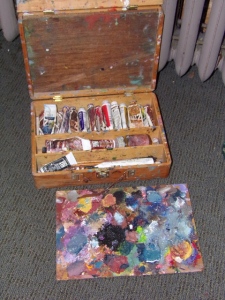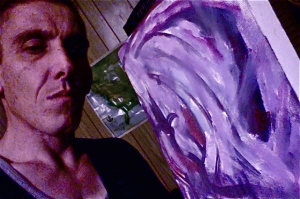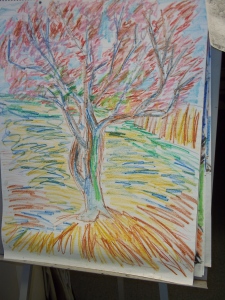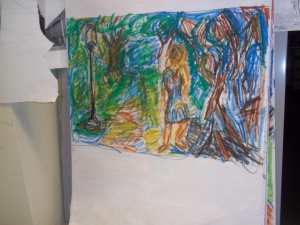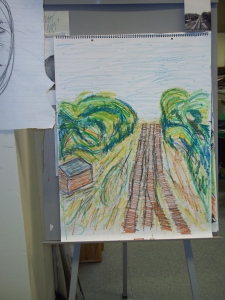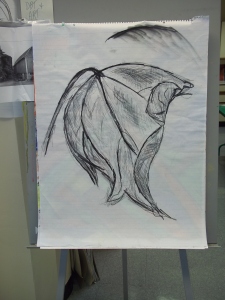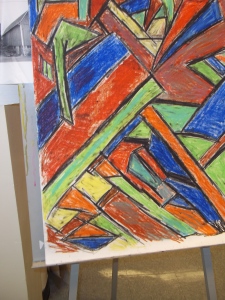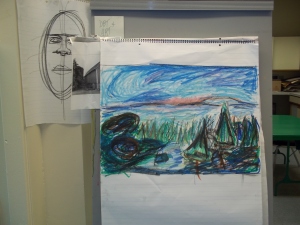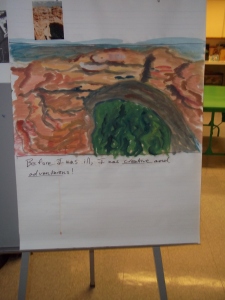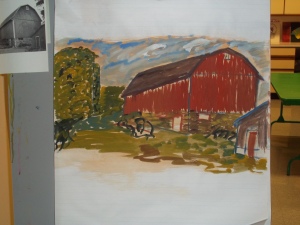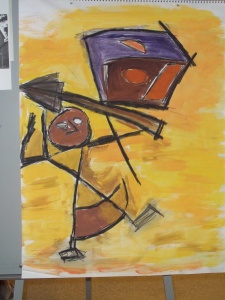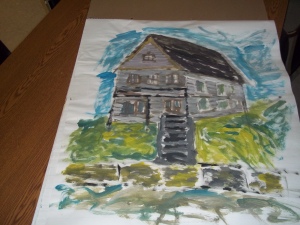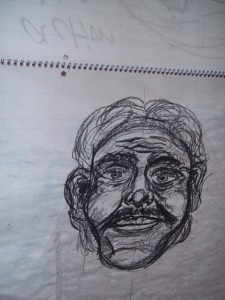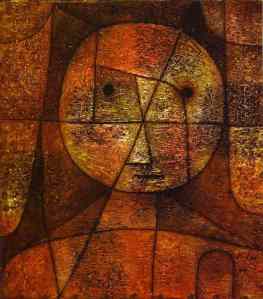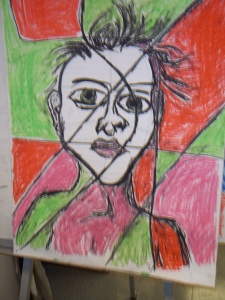First of all, many thanks to Julie at OMH for making this possible, by letting me hitch a ride. Secondly, thanks to Chris Randolph of the Rockland Living Museum for being so generous with her time.
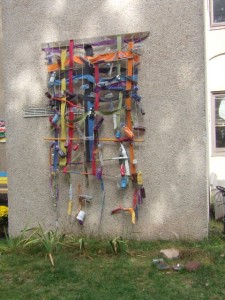
A sculpture made of found objects, it works as a wind chime. At the Rockland Living Museum
I didn’t teach my usual class today. I actually spent the day riding down to Rockland Psychiatric Center to view that hospital complex. Mostly, I am looking to see the Rockland Living Museum. The Living Museum at Creedmore has long been the act to follow in what I do. It’s my goal at CDPC to create a peer-run art therapy program that makes meaningful changes in the lives of the students in my classroom. Through a conversation with my contact for the Art on 8 gallery shows, I learned she makes frequent trips to Rockland Psychiatric Center. There’s a counterpart to Creedmore’s Living Museum there. So, at 8:30am this morning I was standing around the OMH Central Office on Holland Avenue, to catch a ride to Rockland Psychiatric Center.
My goal here was a simple one: to see what people at larger, long-running art therapy programs were doing and learn from that. Compared to CDPC which has a capacity of about 136 people in a single building, Rockland has a sprawling campus of buildings (many of which are abandoned). Post-deinstitutionalization, Rockland is a much smaller operation than when its reputation was much grimmer. I had heard about Rockland because of an innovative art program. A little searching around the web reveals the hospital was once considered a pretty bleak and hopeless place by many locals (its location is about 17 miles north of Manhattan). As I’m researching this blog about the history of Rockland, I quickly loose interest in the more salacious bits of its history. Grim suggestions of an overwrought staff and abused and neglected population dominates a lot of commentary from those who knew it or lived or worked there. I’m not looking for horror stories, not now, though I may read up on that later.
Lately, I am in the business of looking for answers to help even the sickest of Albany’s psychiatric patients recover and reintegrate into the community as much as possible. What I do, I do to get people well and empowering them to keep it that way. I have to believe people do recover and stay well, because I need to believe it for myself. Before I taught an art class at CDPC (as I remind the students in my classroom) I sat in the same chairs they are sitting in. Art therapies are a way to bring people out, and help them recover from severe and persistent mental illness. That’s what brings me to meet Chris Randolph today.
Chris Randolf is an art therapist. Her professional profile on a popular web site shows she once worked at a private facility in the same upstate New York county I was raised in, near a hospital where I was sometimes hospitalized, all in the city where I lived in a group home for 9 months. She’s the director of Rockland’s Living Museum, and over the phone she agrees to meet with me when I describe myself as the teacher of a peer-run art class. She does this a day before my arrival. She is even unfazed when my ride calls and asks her to meet me a couple hours ahead of when the Living Museum opens.

This serves as an outdoor sign for the Living Museum, part of a sculpture garden patients are rebuilding after it was damaged by a severe storm.
It’s far too warm for a day in October. I tend to be extraordinarily anxious in longer car rides. Mercifully, I get a stop at the rest stop mid-way. Lately especially, whenever I am in situations I can’t get up and move around I get stressed out. Nonetheless, since we arrive early, I am offered a breif tour of the whole facility before we park to sign in at the modern main building.
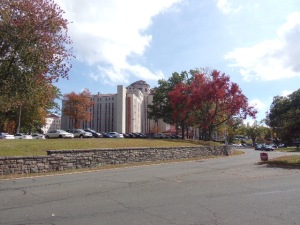
The main, modern building at Rockland, I find, reminds me in an unpleasant way of a building at Pilgrim State Hospital. This isn’t the best picture to show that, but the similarity is there, and the psychological effect of the imposing building is the same.
Much of Rockland’s Campus is a series of ivy-covered, abandoned buildings. I am treated to the site of decaying structures bedecked in color, thanks to turning leaves. Here is one of those images, but I am intending most of that for another blog.

The buildings in the abandoned portions of Rockland’s campus are still accessible. A walking path on the campus goes right along them.
My traveling companions sign in, and in a few minutes, Chris is on her way to pick me up to bring me across campus to Building 19, where the Living Museum anchors a large room of one side of the Recovery Center. We park in a small lot at the back, and Chris begins to show me the work that takes up her day from 1-4, when the Living Museum is open. She has the help of art therapy interns to work directly with the patients. Still, she seems to have a small anecdote for nearly every object outside. Aftr seeing the garden, we get into the actual studio in which the museum’s art is created, by residents of the hospital (many of whom are beginning to transition out of inpatient care).
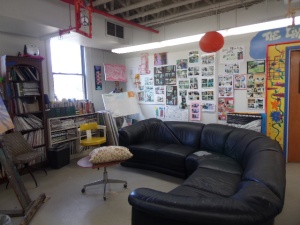
The Living Museum has several areas which allow patients to work, and relax, listen to music or enjoy a cup of hot tea. Art by patients decorates the room throughout.
The Rockland Living Museum was developed based on the pioneering Living Museum at Creedmore Hospital in Queens, NYC. The emphasis is on a peer-run program which uses art therapy to empower patients and assist recovery from mental illness. Under the direction of Dr. Janos Marton, a 2002 New York Times profile described the mission of the Living Museum as being a place of “refuge” where “over 800 men and women shed their identities as psychiatric patients and bloomed as artists.”
Patients simply come into the Living Museum space, and without lessons, or direction, they make art. That art has been widely exhibited. It is a series of paintings by patients at the Rockland Museum that piques my interest. At the Art on 8 exhibit (which I have my own work in, as do many of my CDPC students) a conversation about the work in the show from the Rockland Living Museum results in a plan for me to visit Rockland.
My own program is a nascent one. I have only just begun working in the hospital in April. I hear many complimentary statement from students. My class is something they look forward to all day and all week. I know I can make it more meaningful and powerful for my students. I know my story is compelling to them. I was sick on and off a long time. I got hospitalized, voluntarily or involuntarily, a lot. Now, I live in my own apartment and pay my bills. I haven’t needed a hospitalization in 4 years. I know it probably seems to my students that I know something they don’t. If there’s any truth to that at all, the thing I know is this: I need all of them as much as they need me.
That I am teaching again is important to me. Also, it matters that I am teaching people with whom I share a common struggle with chronic mental illness. Its my personal belief is that mentally ill people need to create a community of mutual support for each other. That’s why I do peer mentoring. I teach art because creating art has always been a large part of my own recovery and healing from mental illness. We as a community of psychiatric survivors, –we need to do it for ourselves.
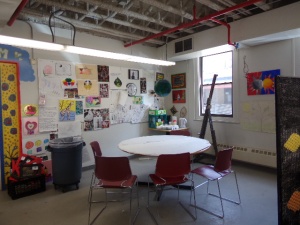
Tables allow patients to work together, although some patents choose to work at stations around the room that are solitary. Great care seems to be taken to meet patient’s needs and allow them to indulge their preferences.
The underlying purpose of the Living Museum is to place art therapy, not as peripheral to people’s recovery, rather creative expression is vital to real and lasting recovery from mental illness. Art groups shouldn’t be in psychiatric hospitals to keep the mentally ill busy. The purpose of art therapy is to make people well. I believe this, of course, because it matches with my own experience. The historical connection between creativity and “madness” is long and widely studied. I’m a working visual artist, as well as a teacher. I know I do much better when I make creativity and expression my purpose.

Art adorns the whole room, and even the rafters. Many objects that become works of art are donated, including tables and chairs which are turned to objects of art. Chris states her goal is to get rid of all the furniture she feels is “institutional” in nature.
After Chris picks me up at Rockland’s central building, I launch on a whirlwind tour of the Rockland Living Museum. We start with its garden. Chris explains that she has about a half-hour before some other responsibility she must attend to. In a short time I have seen a lot of things which inspire me, and leave me with a great number of ideas for my own work at CDPC. I also see the enormity of the task I’m trying to undertake.
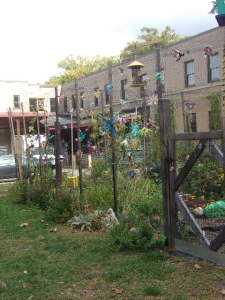
Nearly every patient who takes part in the Living Museum contributes in some way to the beauty or the tending of this garden.
The garden grows flowers, or herbs and vegetables intended for use in the food at the Big Rock Café. The cafe is a locus of food and conversation for many patients, and its walls also serve to exhibit work done by patients in the Living Museum.
In the Living Museum’s garden, some patients have taken plastic bottles and fashioned them as flowers decorated in vivid colors. Some patients have decorated the ground with painted stone tiles. Another has made small seats for rest or contemplation. Still others simply tend the garden and their contribution is watering the plants and weeding. It strikes me that Chris not only knows each person and their contribution to the garden, but she seems to have found a way to match each person to a way their skills and limitations still allow them to take a meaningful part.
For those of us in the peer/consumer movement, this is what’s known as a “strengths based approach.” The medical model of treatment focused on the deficits of a ill person. Medical professionals list symptoms, and address limitations. Throughout my time in the Rockland Living Museum, the focus remains on building and fostering the skills and abilities of people in treatment. Participants in the Living Museum direct their own projects. They choose their creative medium based on their already presents skills and interests. One man, Tommy, does most of the building in wood, a large section of the room is a dedicated space where he builds benches, chairs, stools and many other projects.

Tommy, who works in wood, has a dedicated space for his projects.
Most of the spaces for the museum’s artists are individual. The space is adapted to the artist and their interests and personalities. Some artists work is crafts or jewelry. The work is self directed, and flexible. Spaces have shelves of donated books, and a small radio for listening to music.

Other artist spaces include easels, shelves of books that are donated, even a handmade coat rack on which some artists have turned old canvases into lovely and unique purses.
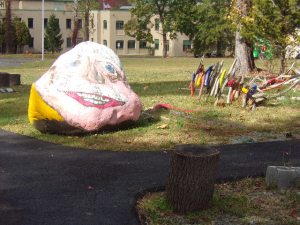
A lesson in resilience: a severe storm recently damaged an outdoor sculpture garden –composed mostly of driftwood. Patients are beginning to stack the wood, and rebuild the sculptures.
In the Living Museum, Chis leads me around from one project to another. Since the space is not yet open and no artists are present, she patiently answers all my questions about her work as director. She relates how the Living Museum started. At the beginning it was just her. Chris gives me many thoughtful recommendations for my own program. Much of the supplies, furniture and other projects are donated items, or carefully gleaned from sites like Craigslist and other free resources. The Living Museum is staffed, in part, by partnering with educational institutions nearby. But primarily, Chris stresses the need to create a program which eschews the traditional therapeutic model. Instead, she insists on a program which empowers patient autonomy and choice. This maxim underlies the program here.
This is of course, something I want for my own program. Changing a deeply entrenched institutional culture is a large task.
After I have seen the actual Living Museum itself, I briefly tour the larger Recovery Center –which constitutes the rest of Building 19. I see spaces that host group therapy, vocational training, computer access, music and performance space, and display space for some of the patient created wares from the Living Museum. I’m given an overview of the other programs. There is an all-day roster of groups available to patients (patients choose their own groups, and participate in creating new groups). I meet both hospital residents and peer mentors like myself. Chris eventually has a supervision to attend to, and I go to the café for lunch.
It’s in the café that The Recovery Center feels institutional to me for the first time. Though the food is fine, and the space is well decorated with the Living Museum’s art, several people mill about the cafe or in front of it in an idle and purposeless way. A couple of the cafés patrons approach me either wanting my coffee, or cigarettes. I talk to a couple of people there, and eventually leave to photograph the wooded, picturesque grounds. Much of the hospital’s campus is abandoned and overgrown. It makes a beautiful subject for my camera, since photographing abandoned buildings is a longstanding hobby of mine.
While I am walking the grounds, seeing all the wrecked former hospital buildings, it seems the hospital campus was abandoned in stages. Nearer the road, buildings are lost almost entirely in overgrowth, and as one gets closer to the center of campus and its modern buildings some of the older buildings are being returned to use. I am not sure, but it is likely that building 19 itself, where the Living Museum is housed, began the renaissance of the older buildings being renovated. It’s speculation on my part, but meaningful speculation.
That I was pestered for cigarettes, money, and coffee in the café reminds me that the needs of the mentally ill are great. People whose needs are being met aren’t listlessly sitting about looking for an opportunity to solicit something they don’t have or have enough of. Back at home, (my work at CDPC) there are a great number of people that need to be meaningfully engaged in addressing their own needs. Those needs may be educational, vocational, or –pertinently– creative expression.
There’s a lot of work to do.
.
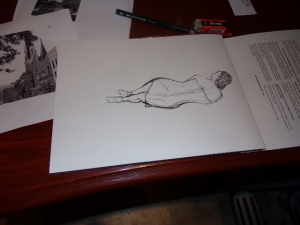 There are a few things currently leading me to change approaches with the class. As I have talked about in other blog posts, over the past fall I was able to travel with a colleague from the Office of Mental Health to The Living Museum in Rockland Psychiatric Center, and the original Living Museum in Queens, NY, at Creedmoor Psychiatric Center. During those times I met with clients of both hospitals who participated in Living Museum activities, as well as had lengthy face-to-face meeting with Chris Randolph (director of the Rockland Living Museum) and Janos Martin (director of the Creedmoor Living Museum). Both Chris Randolph and Janos Martin were very helpful and encouraging, –and excited that a peer run program may be coming to CDPC. CDPC is a much smaller psychiatric hospital, up the Hudson River, in Albany, NY. Both of them, however, recommended that one of the first changes I needed to make to my own program at CDPC was to change my teaching approach. I needed to model on my emerging program on the principles important to the Living Museum programs and other peer programs like it. I had been, as a teacher, essentially approaching the class as a teacher-directed lesson. I had been teaching the class by choosing the topic. I then led the class in developing that particular skill I was teaching.
There are a few things currently leading me to change approaches with the class. As I have talked about in other blog posts, over the past fall I was able to travel with a colleague from the Office of Mental Health to The Living Museum in Rockland Psychiatric Center, and the original Living Museum in Queens, NY, at Creedmoor Psychiatric Center. During those times I met with clients of both hospitals who participated in Living Museum activities, as well as had lengthy face-to-face meeting with Chris Randolph (director of the Rockland Living Museum) and Janos Martin (director of the Creedmoor Living Museum). Both Chris Randolph and Janos Martin were very helpful and encouraging, –and excited that a peer run program may be coming to CDPC. CDPC is a much smaller psychiatric hospital, up the Hudson River, in Albany, NY. Both of them, however, recommended that one of the first changes I needed to make to my own program at CDPC was to change my teaching approach. I needed to model on my emerging program on the principles important to the Living Museum programs and other peer programs like it. I had been, as a teacher, essentially approaching the class as a teacher-directed lesson. I had been teaching the class by choosing the topic. I then led the class in developing that particular skill I was teaching.